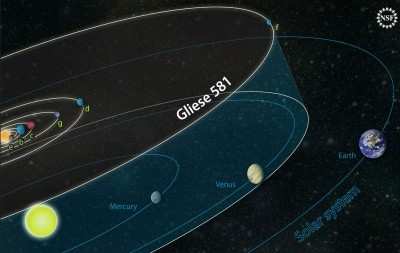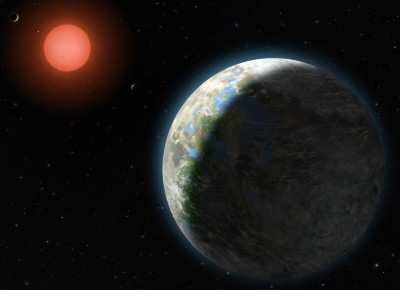Observations Show Planet In Its Host Star's 'Habitable
Zone'
A team of planet hunters from the University of California (UC)
Santa Cruz, and the Carnegie Institution of Washington has
announced the discovery of a planet with three times the mass of
Earth orbiting a nearby star at a distance that places it squarely
in the middle of the star's "habitable zone."

NASA-NSF Image
This discovery was the result of more than a decade of
observations using the W. M. Keck Observatory in Hawaii, one of the
world's largest optical telescopes. The research, sponsored by NASA
and the National Science Foundation, placed the planet in an area
where liquid water could exist on the planet's surface. If
confirmed, this would be the most Earth-like exoplanet yet
discovered and the first strong case for one that is potentially
habitable.
To astronomers, a "potentially habitable" planet is one that
could sustain life, not necessarily one where humans would thrive.
Habitability depends on many factors, but having liquid water and
an atmosphere are among the most important.

The new findings are based on 11 years of observations of the
nearby red dwarf star Gliese 581 using the HIRES spectrometer on
the Keck I Telescope. The spectrometer allows precise measurements
of a star's radial velocity (its motion along the line of sight
from Earth), which can reveal the presence of planets. The
gravitational tug of an orbiting planet causes periodic changes in
the radial velocity of the host star. Multiple planets induce
complex wobbles in the star's motion, and astronomers use
sophisticated analyses to detect planets and determine their orbits
and masses.
"Keck's long-term observations of the wobble of nearby stars
enabled the detection of this multi-planetary system," said Mario
R. Perez, Keck program scientist at NASA Headquarters in
Washington. "Keck is once again proving itself an amazing tool for
scientific research."
Steven Vogt, professor of astronomy and astrophysics at UC Santa
Cruz, and Paul Butler of the Carnegie Institution lead the
Lick-Carnegie Exoplanet Survey. The team's new findings are
reported in a paper published in the Astrophysical Journal and posted online. "Our
findings offer a very compelling case for a potentially habitable
planet," said Vogt. "The fact that we were able to detect this
planet so quickly and so nearby tells us that planets like this
must be really common."

The paper reports the discovery of two new planets around Gliese
581. This brings the total number of known planets around this star
to six, the most yet discovered in a planetary system outside of
our own. Like our solar system, the planets around Gliese 581 have
nearly-circular orbits.
The new planet designated Gliese 581g has a mass three to four
times that of Earth and orbits its star in just under 37 days. Its
mass indicates that it is probably a rocky planet with a definite
surface and enough gravity to hold on to an atmosphere.

Gliese 581g Artists Rendering
Gliese 581, located 20 light years away from Earth in the
constellation Libra, has two previously detected planets that lie
at the edges of the habitable zone, one on the hot side (planet c)
and one on the cold side (planet d). While some astronomers still
think planet d may be habitable if it has a thick atmosphere with a
strong greenhouse effect to warm it up, others are skeptical. The
newly-discovered planet g, however, lies right in the middle of the
habitable zone.
The planet is tidally locked to the star, meaning that one side
is always facing the star and basking in perpetual daylight, while
the side facing away from the star is in perpetual darkness. One
effect of this is to stabilize the planet's surface climates,
according to Vogt. The most habitable zone on the planet's surface
would be the line between shadow and light (known as the
"terminator").
 ANN's Daily Aero-Linx (04.13.24)
ANN's Daily Aero-Linx (04.13.24) ANN's Daily Aero-Term (04.13.24): Beyond Visual Line Of Sight (BVLOS)
ANN's Daily Aero-Term (04.13.24): Beyond Visual Line Of Sight (BVLOS) Airborne 04.09.24: SnF24!, Piper-DeltaHawk!, Fisher Update, Junkers
Airborne 04.09.24: SnF24!, Piper-DeltaHawk!, Fisher Update, Junkers Aero-News: Quote of the Day (04.14.24)
Aero-News: Quote of the Day (04.14.24) ANN's Daily Aero-Term (04.14.24): Maximum Authorized Altitude
ANN's Daily Aero-Term (04.14.24): Maximum Authorized Altitude






